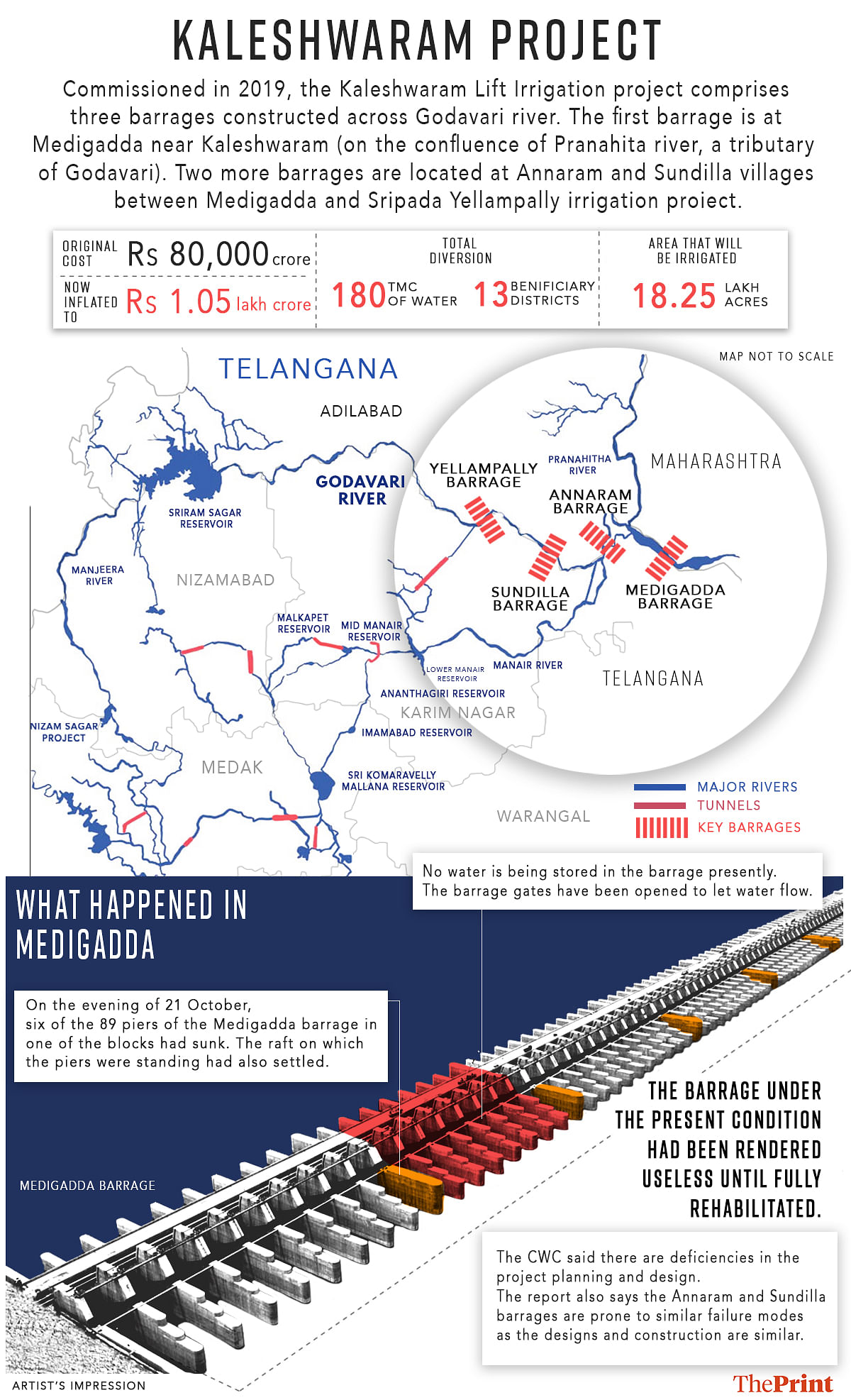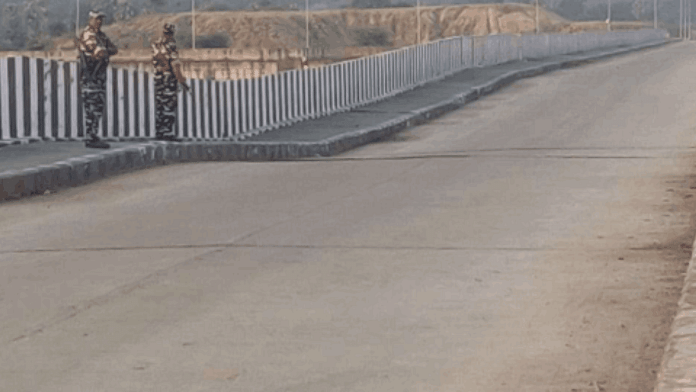Hyderabad: The Kaleshwaram Lift Irrigation Project, a showpiece of the K. Chandrashekar Rao-led Telangana government costing more than Rs 1 lakh crore, has become a hot-button political issue after the sinking of six piers of one of its barrages last month, just four years after the project was commissioned.
One of the biggest and costliest irrigation projects, it was undertaken soon after Telangana was formed in 2014 and completed in a record three years. It comprises three barrages constructed across the Godavari River at three villages — Medigadda, Annaram and Sundilla. These are also called the Laxmi, Saraswati and Parvati barrages respectively.
When fully operational, these barrages diverted 195 TMC (thousand million cubic feet) of water to irrigate approximately 18.25 lakh acres of farmland in 13 districts in drought-prone regions of Telangana through a network of canals, tunnels, lift systems and reservoirs.
The project also provided 30 TMC drinking water to Hyderabad and Secunderbad cities, 10 TMC of drinking water to villages and 16 TMC water for industrial use, according to the information available on the irrigation department website.
It was six of the 89 piers at Medigadda in Karimnagar district that sank 1.2 metres last month, along with the raft (foundation) on which they were standing.
This has triggered a blame game between the Narendra Modi-led Centre and the KCR-led state government. The National Dam Safety Authority (NDSA), which inspected the Medigadda barrage after the incident came to light, has pointed to “construction deficiencies due to lack of stringent quality control” and “deficiencies in project planning and design” that led to the failure.
However, several central agencies had given clearances for different aspects of the project.
Dam sector experts, including serving and retired engineers and civil servants at the Centre and state who have worked in irrigation sector, told ThePrint that a thorough investigation is required.
“Piers and a raft sinking just four years after being commissioned is a rare thing. It raises serious questions about the future of the project,” said a senior NDSA official.
N. Venkateshwarlu, engineer-in-chief of the Kaleshwaram project, however, ruled out any lapse in either the design or the construction of the project. “The design and construction of the Kaleshwaram project was done as per the specified standard laid down for such projects. We have not cut any corners. It’s an accident that has happened, which will be rectified,” he said.
The Medigadda barrage was built by construction major L&T. Following the incident, the company issued a statement saying it had constructed the barrage in accordance with the design provided by the state government.
Also read: ‘Unsubstantiated, hasty’ — KCR govt dismisses central agency report on Kaleshwaram project ‘flaws’
Over half a dozen central agencies gave clearances
Although the project was funded and executed by the state government, since 2016 — when Telangana signed an agreement with Maharashtra to allow it use some of the water — more than half a dozen central agencies had given clearances for different aspects, including planning, hydrology and cost-benefit analysis.
These agencies include the Central Water Commission (CWC), Central Ground Water Board, Central Soil and Material Research Station, Central Water and Power Research Station, and WAPCOS, a central public sector enterprise.
Besides these, the Union Jal Shakti ministry’s Technical Advisory Committee had also approved the overall project. ThePrint has accessed the documents of central agencies’ appraisals and clearances.
Experts say while the primary accountability for design deficiencies and poor operation and maintenance lies with the state, the central agencies can’t brush off their responsibilities either.

“If there were issues with planning and design, shouldn’t the central agencies have flagged it before giving clearances? Kaleshwaram is a mega project involving huge cost, and even the slightest deficiency can prove to be dangerous,” said a retired Andhra Pradesh cadre IAS officer who has handled the Polavaram dam project.
S.K. Sibal, member (design and research), CWC, who also holds the additional charge of NDSA chairman, said, “The CWC checks issues related to hydrology based on water availability as well as inter-state matters. We will not look into the design of the project if it has been approved by the state irrigation department’s Central Designs Organisation (CDO).”
According to CWC guidelines, if a state submits a certificate from the CDO chief engineer saying they have examined the project design while preparing the detailed project report, there is no need for the commission to carry out a detailed examination of design aspects.
Beside the failure of the barrage raft at Medigadda, a team from the NDSA had also seen signs of water seeping through the foundation of the second barrage at Annaram, which they say is a precursor to failure.
In its report, the NDSA has said, “Annaram and Sundilla barrages have similar designs and construction methodologies as Medigadda, making them prone to similar failure modes.”
Question mark over Kaleshwaram’s future
The Medigadda barrage was built at a cost of Rs 3,662 crore, the one at Annaram at a cost of Rs 2,195 crore and the Sundilla barrage at a cost of Rs 1,811 crore.
After last month’s incident, Medigadda is out of operation, while very limited quantities of water are being stored at Annaram and Sundilla despite the NDSA advising against it.
State irrigation department officials admit that water is also not being lifted to the Annaram and Sundilla barrages. ”No water is currently available for irrigation from these three barrages,” the irrigation department official quoted earlier said.

But it’s not just the failure of six piers at Medigadda and water seeping through the foundation at Annaram that has become a matter of concern.
In his reply to the NDSA on 1 November, state irrigation secretary Rajat Kumar said that there is a need to revise the apron design of the Medigadda barrage. Detailed model long studies were done jointly with IIT Hyderabad but the modifications could not be implemented due to continuous rains in the basin and flows in the barrage for the last three years. (The apron prevents abrasion due to water flow from the barrage.)
While the original cost of the Kaleshwaram project was Rs 80,000 crore, it has now escalated to Rs 1.05 lakh crore, said a senior irrigation department official. So far, the main trunk, comprising 80 percent of the project, has been completed. “The distributary network of the project to carry the water to the fields is under execution,” the official added.
According to a policy statement tabled in the state assembly, the Telangana government has allocated a budget for the project from state funds and also set up a Special Purpose Vehicle — Kaleshwaram Irrigation Project Corporation Ltd — to raise financial assistance from a consortium of nationalised banks, the Power Finance Corporation, the Rural Electrification Corporation and NABARD.
It will take the state government a long time to complete the repayment of loans along with interest for the project.
An article was published in Telugu newspaper Eenadu this July based on the draft CAG report on the Kaleshwaram project. It said that, assuming the project would become fully operational from the year 2024-25, the funds required for operation — including debt servicing — would range from Rs 11,359 crore to Rs 25,109 crore. The electricity charges for lifting of water to the barrage would be over Rs 10,000 crore annually, according to the report.
A retired chief engineer who was associated with the project said that considering the huge costs involved, it is important that the Medigadda barrage be repaired and made operational.
At least a year to repair the damage
State irrigation secretary Kumar told ThePrint that the barrage gates at Medigadda had been opened after the incident. “We are not storing any water to avoid further damage to the structure,” he said.
Kumar added that an investigation to examine the foundation structure and assess why the raft and piers sank, and if there has been an impact on the other blocks, will start by the end of the month.
“Though there is no water stored in the barrage, there is inflow from the Godavari. We are building a temporary coffer dam upstream, where water from Medigadda will be diverted. This will be completed in the next 15-20 days. After the water is drained out, a team will go in and investigate,” he said.
Venkateshwarlu, the engineer-in-chief of the project, said the restoration work would start once the investigation is complete. “It will take at least a year to repair and rehabilitate the project.”
However, he added that the Medigadda barrage being out of commission would not come in the way of irrigating the areas downstream, where the Rabi cropping season has started.
“There is enough water in Sripada Sagar Yellampalli barrage, where water lifted from the three barrages of the Kaleshwaram project goes. From here, the water is distributed downstream through a network of canals and also stored in online reservoirs during the monsoon season. We will use the water for irrigation. We do not anticipate any problem.”
The officer said that on an average, 30-36 TMC water is required during the Rabi cropping season, and the water stored in the various reservoirs downstream of the Yellampalli barrage is more than that.
‘Jinxed’ project?
The Kaleshwaram irrigation project took off from its predecessor, the Pranhita-Chevella project, which envisaged diversion of 160 TMC of water by constructing a barrage across the River Pranahita (a tributary of the Godavari) at Tummidihetti to irrigate the arid regions of undivided Andhra Pradesh (AP).
The then CM of Andhra Pradesh, Y.S. Rajasekhara Reddy, had laid the foundation stone of the project in 2008. The CWC gave in-principle consent for the preparation of a detailed project report in 2010. The Rs 40,000 crore Pranahita-Chevella project proposed to irrigate 16.4 lakh acres of agricultural fields in seven districts. After the CWC’s in-principle approval, AP started work to get various regulatory clearances from the CWC and other central agencies.
But the agitation to bifurcate the state was growing strong around that time and bore fruit in 2014, when Telangana was carved out and KCR became its CM.
“Soon after he took charge, the CM announced that the project will be re-engineered to cover more areas under irrigation. Citing concerns by the Maharashtra government about submergence of areas in the state, the barrage location was shifted from Tummidihetti to Kaleshwaram and the project name was changed,” the retired IAS officer quoted above said.
The officer added: “The concept was the same but the Kaleshwaram project was made much grander. Instead of one barrage as earlier, the project now had three and the number of districts to be irrigated was increased from 7 to 13. The capacity of reservoirs was also increased.”
According to irrigation department documents that ThePrint has accessed, the re-engineering led to the project cost increasing from Rs 40,000 crore to Rs 80,000 crore. The original proposal was abandoned and work started on the Kaleshwaram project.
(Edited by Smriti Sinha)
Also read: In poll-bound Telangana, Oppn corners ruling BRS as central panel report casts shadow on Kaleshwaram



